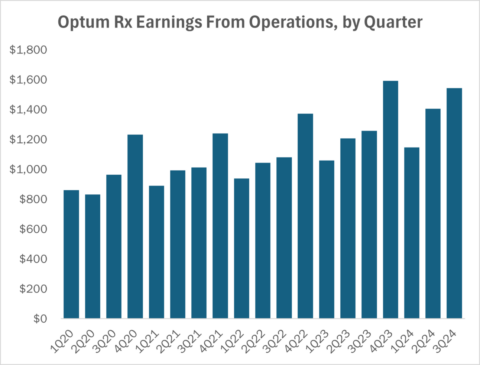If you want to search Cost Curve back issues or link to anything you read here, the web links and archive are online at costcurve.beehiiv.com. You can subscribe there, too.
It’s all PBMs again, today. Three things to highlight.
ONE: Execs from the big PBMs will start testifying on Capitol Hill shortly. You can follow along here. I don’t expect much. We’ll get some angry member statements that will fuel coverage. And we’ll get some obfuscation from the execs. The most potent weapon that PBMs possess is the complexity of the business, and I expect to see the weapon deployed effectively today.
TWO: The House Oversight Committee is hosting the hearing today, and the committee put out a report that is, unsurprisingly, critical of the PBMs. I haven’t had the chance to go through it (it just hit the website), but the Wall Street Journal was given the exclusive, and it’s a good summary if you are caffeinated and must rush.
From what I can tell, the Oversight report covers a lot of the same ground that the FTC did, documenting the way that consumers can be pushed by PBMs toward higher-priced drugs and higher-priced pharmacies. None of this is new, but it does provide plenty of ammo for the hearing.
THREE: Antonio Ciaccia of 46Brooklyn/3Axis Advisors fame dropped a PBM report of his own yesterday. The 46Brooklyn crew downloaded a giant CMS dataset and extracted about a zillion different prices being charged by different PBMs in the Medicare program.
I suspect that a lot of people are going to miss Antonio’s point here, in part because report spends some time comparing PBM prices for medicines to Mark Cuban prices. That analysis led to a couple of compelling findings:
In general, the average Medicare beneficiary taking average generic drugs in an average plan is probably better off using insurance than paying Cuban’s price.
BUT, at the edges, the PBM prices for a handful of high-priced specialty generics (think imatinib or abiraterone) are incomprehensibly high compared to the Cuban price.
But those two conclusions merely support what’s already out there in the literature.
What’s really interesting and really important is the fact that each PBM has dozens — or sometimes hundreds — of different prices for the same drug, often with a massive spread between them.
Reading the report, that’s clearly the bit that blew Antonio away. It’s not like PBMs take the manufacturer’s price, do some common-sense adjustments, and set the plan price. If they did that, prices would all be generally similar. Instead, there’s something else going on that is not remotely self-evident.
The real takeaway from Antonio’s work is that PBMs have an enormous ability to set prices, and they do so in a way that is nearly impossible to parse. It’s hard to understand why a PBM would offer one price in one Medicare plan and a price that is a hundred times higher in another.
At the risk of repeating myself, the most potent weapon that PBMs possess is the complexity of the business. With every layer of the onion that gets peeled back, that complexity only becomes more profound.
Quick Turns today contains a handful of things that I find to be minorly irritating. Bear with me this morning.
First up is the news from STAT that there’s research about to be published that shows that Gilead’s twice-a-year HIV med can be produced for as little as $26 a year per person. This comes on the heels of the much-cited, similarly silly estimate of the manufacturing costs of GLP-1 medicines.** What chaps my hide is that these are essentially stunts: the marginal cost of drug manufacturing is not what drives price, and oversimplifying in that way distorts the conversation. I’m worried that this stunt is so successful at generating attention that we’re going to see a lot more of it. Sigh.
I’m also irritated by this STAT First Opinion piece suggesting that the government could spend so much on obesity medicines in Medicare that it might make sense to purchase Novo Nordisk outright. This is presented as an intentionally hyperbolic thought experiment, but it’s also based on a set of wildly off-base assumptions about present and future costs and spending. Again: a fun stunt that obscures what we should really be talking about.
I’m not particularly vexed by this Viewpoint in JAMA by the Harvard PORTAL folks that advocates for reforms that would make the FDA less stingy with trade secret information, though I am wary. It feels like this is the start of another policy push that will follow the Arnold Ventures playbook … I expect to see this cause pop up as a legislative priority in the not-too-distant future.
STAT did a good job spotting the news out of North Carolina that its Medicaid program will cover obesity meds. The state has been vocal about not covering the drugs for state workers. Turns out these decisions are hard, and how you look at the data goes a long way toward determining the outcomes.
**As an FYI, any time you see a story that mentions there is research that shows that obesity meds can be profitably produced for $5 a month, remember that the author of that study went on live television and dropped some amazing quotes, including “I’m not trying to say, ‘what does it cost Novo Nordisk, today, to manufacture the drug” and “I’m not accounting for innovation. Yes, that’s true.”
Header image via Flickr user naql.
Thanks for reading this far. I’m always flattered when folks share all or part of Cost Curve. All I ask is for a mention or tag. Bonus points if you can direct someone to the subscription page.





